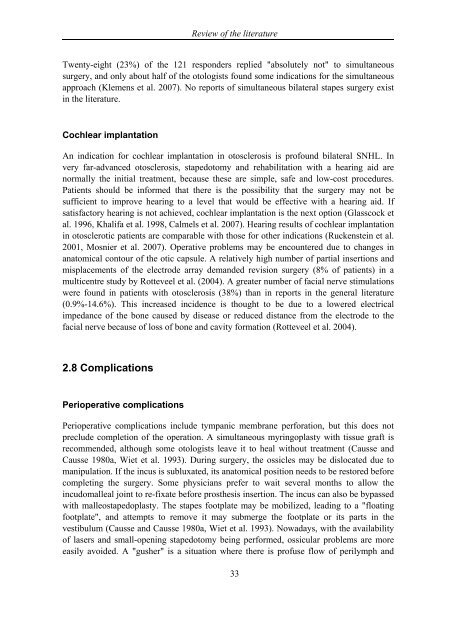Modern surgical treatment of otosclerosis - Helda - Helsinki.fi
Modern surgical treatment of otosclerosis - Helda - Helsinki.fi
Modern surgical treatment of otosclerosis - Helda - Helsinki.fi
You also want an ePaper? Increase the reach of your titles
YUMPU automatically turns print PDFs into web optimized ePapers that Google loves.
Review <strong>of</strong> the literature<br />
Twenty-eight (23%) <strong>of</strong> the 121 responders replied "absolutely not" to simultaneous<br />
surgery, and only about half <strong>of</strong> the otologists found some indications for the simultaneous<br />
approach (Klemens et al. 2007). No reports <strong>of</strong> simultaneous bilateral stapes surgery exist<br />
in the literature.<br />
Cochlear implantation<br />
An indication for cochlear implantation in <strong>otosclerosis</strong> is pr<strong>of</strong>ound bilateral SNHL. In<br />
very far-advanced <strong>otosclerosis</strong>, stapedotomy and rehabilitation with a hearing aid are<br />
normally the initial <strong>treatment</strong>, because these are simple, safe and low-cost procedures.<br />
Patients should be informed that there is the possibility that the surgery may not be<br />
suf<strong>fi</strong>cient to improve hearing to a level that would be effective with a hearing aid. If<br />
satisfactory hearing is not achieved, cochlear implantation is the next option (Glasscock et<br />
al. 1996, Khalifa et al. 1998, Calmels et al. 2007). Hearing results <strong>of</strong> cochlear implantation<br />
in otosclerotic patients are comparable with those for other indications (Ruckenstein et al.<br />
2001, Mosnier et al. 2007). Operative problems may be encountered due to changes in<br />
anatomical contour <strong>of</strong> the otic capsule. A relatively high number <strong>of</strong> partial insertions and<br />
misplacements <strong>of</strong> the electrode array demanded revision surgery (8% <strong>of</strong> patients) in a<br />
multicentre study by Rotteveel et al. (2004). A greater number <strong>of</strong> facial nerve stimulations<br />
were found in patients with <strong>otosclerosis</strong> (38%) than in reports in the general literature<br />
(0.9%-14.6%). This increased incidence is thought to be due to a lowered electrical<br />
impedance <strong>of</strong> the bone caused by disease or reduced distance from the electrode to the<br />
facial nerve because <strong>of</strong> loss <strong>of</strong> bone and cavity formation (Rotteveel et al. 2004).<br />
2.8 Complications<br />
Perioperative complications<br />
Perioperative complications include tympanic membrane perforation, but this does not<br />
preclude completion <strong>of</strong> the operation. A simultaneous myringoplasty with tissue graft is<br />
recommended, although some otologists leave it to heal without <strong>treatment</strong> (Causse and<br />
Causse 1980a, Wiet et al. 1993). During surgery, the ossicles may be dislocated due to<br />
manipulation. If the incus is subluxated, its anatomical position needs to be restored before<br />
completing the surgery. Some physicians prefer to wait several months to allow the<br />
incudomalleal joint to re-<strong>fi</strong>xate before prosthesis insertion. The incus can also be bypassed<br />
with malleostapedoplasty. The stapes footplate may be mobilized, leading to a "floating<br />
footplate", and attempts to remove it may submerge the footplate or its parts in the<br />
vestibulum (Causse and Causse 1980a, Wiet et al. 1993). Nowadays, with the availability<br />
<strong>of</strong> lasers and small-opening stapedotomy being performed, ossicular problems are more<br />
easily avoided. A "gusher" is a situation where there is pr<strong>of</strong>use flow <strong>of</strong> perilymph and<br />
33

















